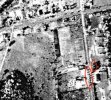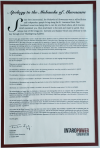During the construction in the 1950's of the St.Lawrence Seaway expansion, several villages were inundated under the immense new lake formed upstream of the Saunders power dam at Cornwall, Ontario. Some structures were moved to higher ground, but those that remained were burned or bulldozed.
This is the village of Wales, originally named "Dickinson's Landing Station". The larger village of Dickinson's Landing was located about 2km further south, just outside the ring of the islands that now form the Long Sault Parkway. The mighty Long Sault rapids of the then untamed St.Lawrence River flowed there. One of the locks of the earlier, much smaller, canal system was also located at the Landing.
The original railway line ran through the village of Dickinson's Landing Station. The name change to "Wales" is described as follows:
Late summer low water levels reveal the remains of this village.
Among so many other sad things to see, particularly poignant more than 60 years later are the exposed stumps of the trees which were cut down from the sides of the road in front of DHC Smith's apple orchard.


This is the village of Wales, originally named "Dickinson's Landing Station". The larger village of Dickinson's Landing was located about 2km further south, just outside the ring of the islands that now form the Long Sault Parkway. The mighty Long Sault rapids of the then untamed St.Lawrence River flowed there. One of the locks of the earlier, much smaller, canal system was also located at the Landing.
The original railway line ran through the village of Dickinson's Landing Station. The name change to "Wales" is described as follows:
"In 1860, Edward, the Prince of Wales, (later King Edward VII), disembarked at Dickinson’s Landing Station, intent on travelling out to the St. Lawrence River for a journey through the Long Sault Rapids. Legend has it that he asked the townspeople why such a little place had such a long name, Dickinson’s Landing Station. Following his visit, the people made application for a post office in the community and the village was named in the Prince’s honour."
see: lostvillages.ca/history/the-lost-villages/wales/
Late summer low water levels reveal the remains of this village.
Among so many other sad things to see, particularly poignant more than 60 years later are the exposed stumps of the trees which were cut down from the sides of the road in front of DHC Smith's apple orchard.












